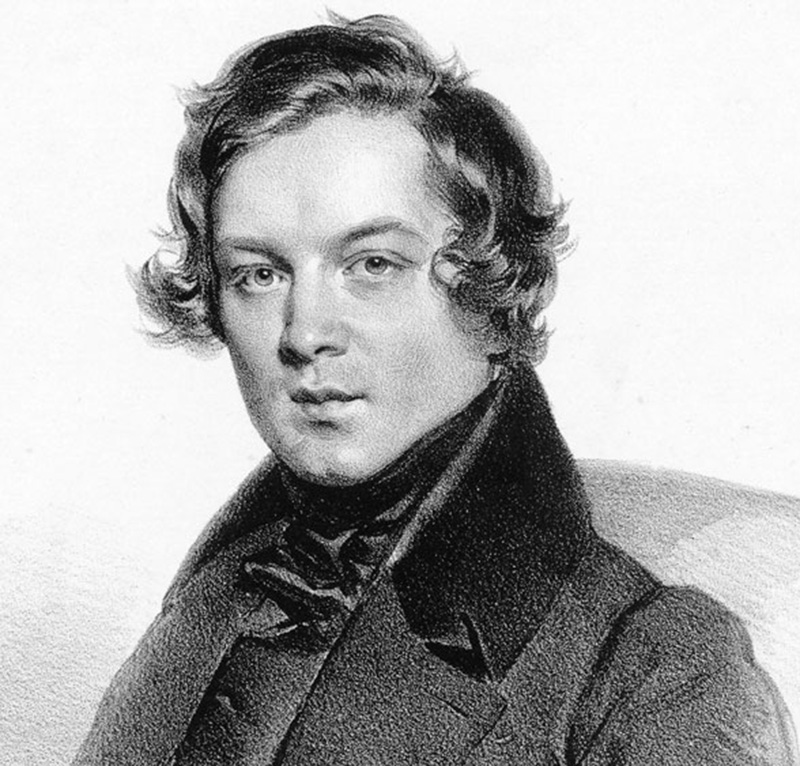Robert Schumann

- Born: June 8, 1810, Zwickau, Germany
- Died: July 29, 1856, Endenich, near Bonn, Germany
Concerto in A Minor for Piano and Orchestra, Op. 54
- Composed: 1841–1845
- Premiere: December 4, 1845, Hôtel de Saxe in Dresden, Ferdinand Hiller, to whom the score is dedicated, conducting; Clara Schumann, pianist
- Instrumentation: solo piano, 2 flutes, 2 oboes, 2 clarinets, 2 bassoons, 2 horns, 2 trumpets, timpani, strings
- CSO notable performances: First Performance: March 1897, Frank Van der Stucken conducting and Adèle aus der Ohe, piano. Most Recent Performance: November/December 2019, James Conlon conducting and Lise de la Salle, piano. Notable pianists who have performed this work with the CSO include José Iturbi (1935), Jesús María Sanromá (1948), Arthur Rubinstein (1955), Claudio Arrau (1967), and Alicia de Larrocha (1969).
- Duration: approx. 31 minutes
Schumann’s Piano Concerto occupied a special place in his loving relationship with his wife, Clara. In 1837, three years before their marriage, Schumann wrote to her of a plan for a concerted work for piano and orchestra that would be “a compromise between a symphony, a concerto and a huge sonata.” It was a bold vision for Schumann who had, with one discarded exception, written nothing for orchestra. In 1841, the second year of their marriage, he returned to his original conception and produced a Fantasia in one movement for piano with orchestral accompaniment. That memorable year also saw the composition of his Symphony No. 1 and the first version of the Fourth Symphony, a burst of activity that had been encouraged by Clara, who wanted her husband to realize his potential in forms larger than the solo piano works and songs to which he had previously confined himself. Schumann had really drawn up his own blueprint for the piano and orchestra work in a prophetic article he wrote in 1839 for the journal he edited, the Neue Zeitschrift für Musik (“New Music Journal”):
We must await the genius who will show us, in a newer and more brilliant way, how orchestra and piano may be combined; how the soloist, dominant at the keyboard, may unfold the wealth of his instrument and his art, while the orchestra, no longer a mere spectator, may interweave its manifold facets into the scene.
The Fantasia seemed to satisfy the desires of both husband and wife. Clara ran through the work at a rehearsal of the Leipzig Gewandhaus Orchestra on August 13, 1841, and Robert thought highly enough of the piece to try to have it published. His attempts to secure a publisher for the new score met with one rejection after another, however, and, with much disappointment, he laid the piece aside.
In 1844, Robert had a difficult bout of the recurring emotional disorder that plagued him throughout his life. After his recovery, he felt a new invigoration and resumed composition with restless enthusiasm. In May 1845, the Fantasia came down from the shelf with Schumann’s determination to breathe new life into it. He retained the original Fantasia movement and added to it an Intermezzo and Finale to create the three-movement Piano Concerto, which was destined to become one of the most popular works in the keyboard repertory.
The public’s initial reaction to the new Concerto, however, was cool. The composition did not have any of the flamboyant virtuosity that was then routinely expected from a soloist (Liszt dubbed it “a concerto without piano”), and the originality of its formal concept put audiences off. Clara, undeterred, was convinced of the work’s value, and she was determined to have it heard. The style of the Concerto even helped her to find a new direction for her own concertizing, since she thereafter left behind the vapid virtuoso showpiece and concentrated instead on the more substantive music of Bach, Beethoven and her husband. As the Schumanns’ French biographer Victor Basch wrote, Clara felt that this change in attitude and repertory “reconciled the discrepancy between her aspiration as an artist and her duties as a wife.” Clara’s perseverance had its reward—she lived to see not only this magnificent Concerto but much of her husband’s music become beloved throughout the world.
Schumann’s Piano Concerto is memorable not only for the beauty of its melodies and the cogency of its expression, but also for the careful integration of its structure. Were the manner in which the work was composed unknown, there would be no way to tell that several years separate the creation of the first from the second and third movements. The Concerto’s sense of unity arises principally from the transformations of the opening theme heard throughout. This opening motive, a lovely melody presented by the woodwinds after the fiery prefatory chords of the piano, pervades the first movement, serving not only as its second theme but also appearing in many variants of tone color, harmony and texture in the development section. Even the coda, placed after a stirring cadenza, uses a double-time marching version of the main theme.
The second movement, the “very essence of tender romance” according to Eugene Burck, is a three-part form with a soaring cello melody in its middle section. The movement’s initial motive, a gentle dialogue between piano and strings, is another derivative of the first movement’s opening theme.
The principal theme of the sonata-form finale is yet another rendering of the Concerto’s initial motive, this one a heroic manifestation in energetic triple meter; the second theme employs extensive rhythmic syncopations. After a striding central section, the recapitulation begins in an unexpected key so that the movement finally settles into the expected home tonality only with the syncopated second theme. The soloist has another rousing cadenza before the work’s close.
—Dr. Richard E. Rodda